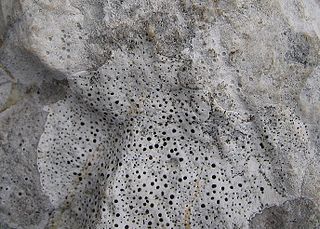
Verrucariales is an order of ascomycetous fungi within the subclass Chaetothyriomycetidae of the class Eurotiomycetes. Although most of the Verrucariales are lichenised, the family Sarcopyreniaceae consists of 11 species of lichenicolous (lichen-dwelling) fungi.
Bellemerella is a genus of fungi in the family Verrucariaceae. All four species are lichenicolous, meaning they grow parasitically on other lichens.
Norrlinia is a genus of two species of fungi in the family Verrucariaceae. The genus was circumscribed by Ferdinand Theissen and Hans Sydow in 1918. The genus name honours the Finnish botanist Johan Petter Norrlin. Both species are lichenicolous, meaning they parasitise lichens. The host of both fungi is the foliose genus Peltigera.
Merismatium is a genus of lichenicolous (lichen-dwelling) fungi of uncertain familial placement in the order Verrucariales. The genus was circumscribed in 1898 by Friedrich Wilhelm Zopf.

Rhizocarpon is a genus of crustose, saxicolous, lecideoid lichens in the family Rhizocarpaceae. The genus is common in arctic-alpine environments, but also occurs throughout temperate, subtropical, and even tropical regions. They are commonly known as map lichens because of the prothallus forming border-like bands between colonies in some species, like the common map lichen.
Subhysteropycnis is a fungal genus in the family Arthoniaceae. This is a monotypic genus, containing the lichenicolous fungus species Subhysteropycnis maculiformans, which is parasitic on Pseudocyphellaria glabra and Pseudocyphellaria homoeophylla.
P. Hans B. Runemark was a Swedish botanist and lichenologist, emeritus professor at Lund University.

A lichenicolous fungus is a parasitic fungus that only lives on lichen as the host. A lichenicolous fungus is not the same as the fungus that is the component of the lichen, which is known as a lichenized fungus. They are most commonly specific to a given fungus as the host, but they also include a wide range of pathogens, saprotrophs, and commensals.
Briancoppinsia is a fungal genus in the family Arthoniaceae. It is monotypic, containing the single species Briancoppinsia cytospora, a lichenicolous fungus that parasitises parmelioid lichens, as well as Cladonia, Lepra, and Lecanora conizaeoides, among others. The species was first described scientifically by Léon Vouaux in 1914 as Phyllosticta cytospora. The genus was circumscribed in 2012 by Paul Diederich, Damien Ertz, James Lawrey, and Pieter van den Boom. The genus was named for Brian John Coppins, who is, according to the authors, an "eminent British lichenologist and expert of lichenicolous fungi".
Lichenosticta is a genus of fungi of uncertain familial placement in the order Lecanorales. It has five species. All species are lichenicolous, meaning they are parasitic on lichens.

Leprocaulaceae is a family of mostly lichen-forming fungi. It is the single family in the monotypic order Leprocaulales. Leprocaulaceae contains three genera and about 33 species.
Xenonectriella subimperspicua is a species of lichenicolous fungus in the family Nectriaceae. It has been recorded from South America, Europe, and New Zealand.
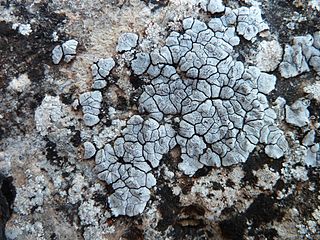
Placocarpus schaereri is a species of saxicolous (rock-dwelling), areolate, and crustose lichen in the family Verrucariaceae. Found in Europe, it is the type species of genus Placocarpus. The lichen was first described scientifically in 1831 by Elias Magnus Fries, who called it Parmelia schaereri. The species epithet honours Swiss pastor and lichenologist Ludwig Schaerer. Othmar Breuss transferred it to the newly reinstated genus Placocarpus in 1985.
Zwackhiomyces calcariae is a species of lichenicolous fungus in the family Xanthopyreniaceae. It was first formally described in 1896 by French lichenologist Camille Flagey, as Arthopyrenia calcariae. Josef Hafellner and Nikolaus Hoffmann transferred it to the genus Zwackhiomyces in 2000. The fungus is parasitic on lichens in genus Aspicilia.
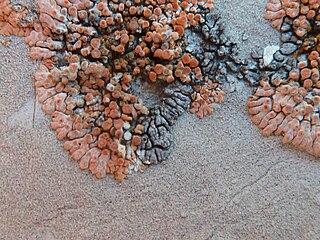
Verrucula arnoldaria is a rare species of lichenicolous (lichen-dwelling) lichen in the family Verrucariaceae. It grows parasitically on the thallus of the rock-dwelling, crustose lichen Calogaya arnoldii. The species was formally described as new to science in 2007 by lichenologists Père Navarro-Rosinés and Claude Roux, from specimens collected in Vaucluse, France. It has also been recorded from Italy. The lichen has a thick brownish-grey, areolate thallus that roughly maintains the shape of its underlying host. The thallus is covered with a crystalline pruina. It makes ellipsoid spores that measure up to about 15 μm long. Its host grows on calciferous rocks and calciferous schists.
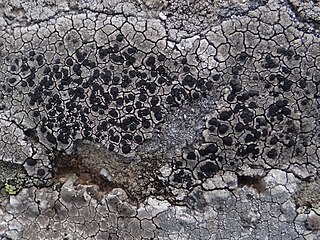
Lecidea lapicida is a species of lichen in the family Lecideaceae. It has a worldwide distribution but it is rare in the tropics.
Rhizocarpon furax is a species of lichen in the family Rhizocarpaceae. It is found in Europe, where it has a scattered distribution.

Calogaya arnoldii is a species of saxicolous (rock-dwelling), crustose lichen that is common and widespread in Europe and Asia. It is in the family Teloschistaceae. It was first formally described as a new species in 1876 by Hugh Algernon Weddell, as a species of Lecanora. After being transferred to Caloplaca in 1915, it was considered as a member of that genus for nearly a century. Molecular phylogenetic studies showed Caloplaca to be polyphyletic, and it was divided up into several smaller genera in 2013. Calogaya arnoldii was one of eight species transferred to the newly circumscribed Calogaya by Ulf Arup, Patrik Frödén, and Ulrik Søchting. The lichen is part of a species complex with complicated taxonomy, and in which intermediate phenotypes are frequently observed, making it difficult to reliably distinguish them. Calogaya saxicola is one such similar species, and it has often been confused with C, arnoldii in areas where they co-occur, as the differences between them are subtle.
Endococcus thelommatis is a species of lichenicolous (lichen-dwelling) fungus in the family Lichenotheliaceae. It was formally described as a new species in 2011 by lichenologists Jana Kocourková and Kerry Knudsen. The fungus grows on the lichen Thelomma santessonii, a common saxicolous (rock-dwelling), crustose lichen that is endemic to the coast and islands of Southern California and Mexico's Baja California. Endococcus thelommatis is the first lichenicolous fungus to have been reported from this lichen.
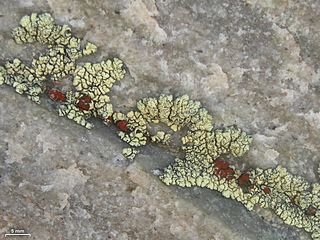
Erichansenia epithallina is a species of saxicolous (rock-dwelling), crustose lichen in the family Teloschistaceae. It is also a lichenicolous lichen species, meaning that it grows on other lichens. Many host genera have been recorded. It occurs in Europe and North America, including Arctic regions.








